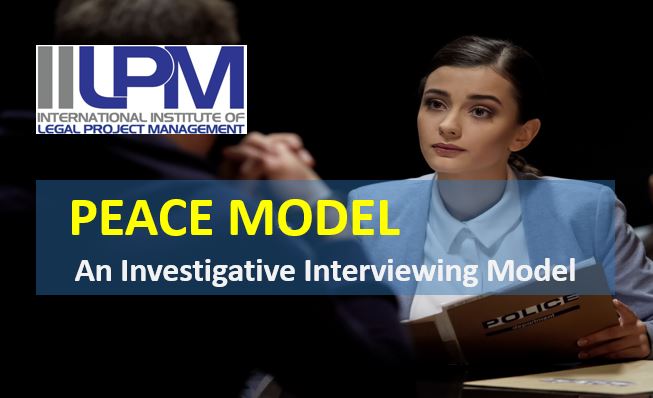Capturing information during an investigative interview is critical and must be done correctly to make the most of the opportunity.
The PEACE model is an investigative interviewing method that comprises 5 basic steps using the PEACE letters to prompt the different phase names of the interview life cycle.
The first “P” phase represents ‘preparation and planning’ that includes reviewing the case and preparing an interview plan. Then setting up the environment for the interview, arranging to record it where appropriate (remembering for the recording you need to define the date, time and parties present), and extends to the start of the interview and the formalities of introducing the parties and starting to build rapport. Building rapport is about trying to create relationships that promote free flowing communications.
The second ‘E’ phase represents ‘engage and explain’ that aims to set out the reasons or objectives for the interview and the routines or expectations that provide adequate context to the intent and process of the interview. Routines can include explaining the management of simple body language like a nod or shake of a head for recording purposes and noting such movements will be acknowledged and explained by the investigator for the purpose of clarifying a response and that the investigator may make written notes during the interview.
Depending on the type of interview and the severity of the case, certain legal rights may need to be conveyed, such as in criminal investigations where legal counsel by the interviewee may be sort and the rights for the interviewee to remain silent and what answers you must response to under law to police investigators (e.g., your name and address, date and place of your birth etc). To safeguard the process, the interviewee needs to made aware of their rights so the interview conversation can be used as evidence in a court of law.
The third “A” phase represents ‘account clarification and challenge’ where the interviewing really starts the focus on the matter. It begins with an opening statement of the case detail and to take and develop an account of events that is driven by either initiating the topic or supporting the person in telling their story. This is where the cycle begins of selecting a topic for probing, engaging in probing, then seeking clarification and challenging the person’s responses. This can then be a repeated process for each investigation topic. These topics may be strategically presented to build a case by getting the interviewee to agree on certain facts as the account is expanded. Sometimes this can include the use of multiple investigators.
The fourth “C” phase represents the ‘closure’ of the interview and to ensure you have any statement, document or recording secured. Depending on the type of investigation, an interviewee statement may need to be signed to give the statement legal strength. Where there is more than on investigator, then the lead investigator should ensure all interviewing parties have asked all their questions. It also requires the lead investigator to finalise any statement, and verbalise the time and date to confirm the end of the recording.
The fifth and final “E” phase represents the ‘evaluation’ of the interview’s process and outcomes. This is where the outcomes of the interview, including evaluating the information, the parties and the interview process. This is where a decision is made for any further action required and to store and distribute any documents or evidence. It is also the opportunity to reflect on the investigator’s interview techniques for them to learn from the experience and improve their future capabilities.
The PEACE model is a framework, but the actual complexities that make an interview successful or not really comes down to the structuring and execution of the questioning, responding to the interview’s statement to probe in the right areas, and taking into consideration all aspects of their response beyond just words, but to include their eye movements, facial expressions, their tonality, mental state and body language.
The investigator needs to look for consistencies in any story and build the evidence that may validate the findings as probable truth.
THIS ARTICLE IS ALSO ON YOU TUBE
Prefer watching a video? Click https://www.youtube.com/watch?v=v_SkHR5tiNQ&t=37s to view the video.
ABOUT THE AUTHOR
Todd Hutchison is an international bestselling business author, a Nationally-accredited trainer, certified speaking professional (CSP), and a global legal project management and behavioural specialist. He is a part of the Executive Team of law firm Balfour Meagher and resides as the Global Chairman of the International Institute of Legal Project Management. Todd is involved in training of police, military, corrective services, lawyers, auditors and investigators.

